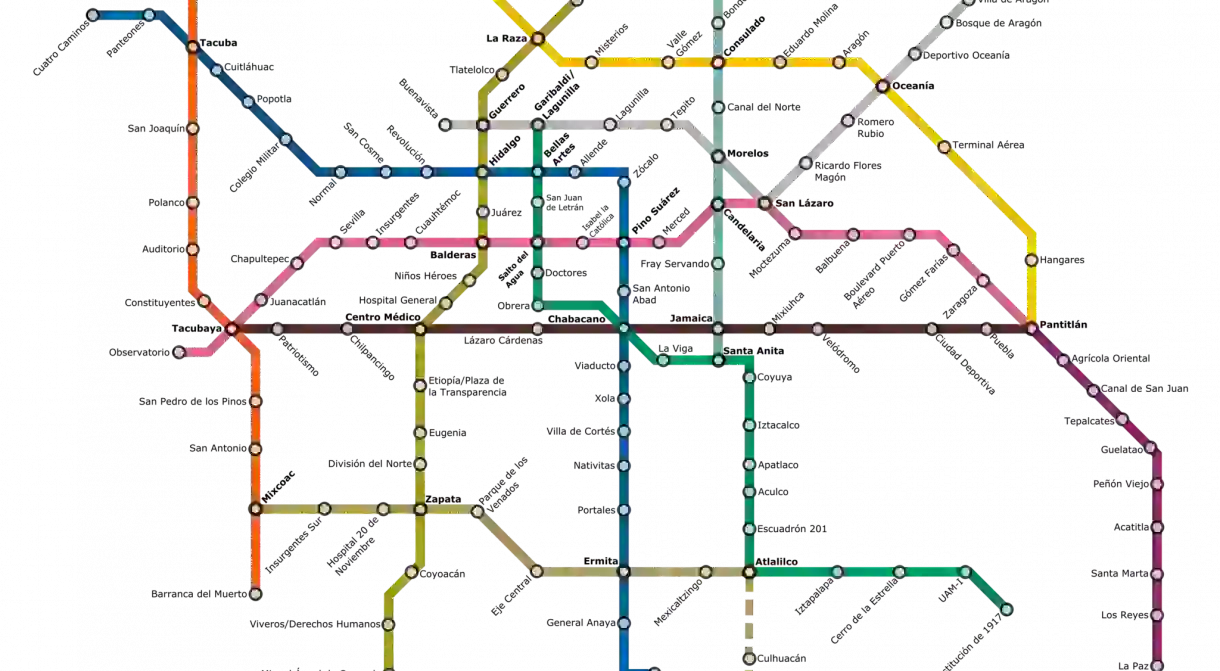A User’s Guide to the Mexico City Public Transport System

Mexico City is one of the most densely populated cities in the world, so suffice to say its public transport system is overcrowded and looking a tad worse for wear. However, it has one of the cheapest metros on earth and such a wealth of lines, routes and stops that you can easily get anywhere in the city without stepping foot in a taxi. Here’s a user’s guide to Mexico City’s public transport.
Metro
The Mexico City metro has a long and fascinating history and currently serves nearly 5 million people on a daily basis. To travel on any one of the 12 lines, which stretch from the very north to the very south of the sprawling capital, you’ll need a ticket or a rail card which you simply swipe at the barriers next to the platform.
To buy either the tickets (known as boletos) or the cards (which cost MXN$20), your first port of call is one of the ticket booths in any metro station, where you pay and state how many tickets/ rides you want.
Price: MXN$5 per ride
Operating hours: From 5am-12am on weekdays, 6am-12am on Saturdays and 7am-12am on Sundays and bank holidays. Avoid travelling at peak times though (7am-10am, 5pm-9pm).


Metrobús
The Metrobús is an above ground, six-line, fixed route alternative to the metro, although it can get just as crowded at peak times, despite only having a daily usage rate of one million passengers. Unlike the metro, you must have a rail/metrobus card to access the stations, swiping it at the turnstile to get onto the platforms; the Metrobús uses the same card as the metro though, making it a worthy investment if you’re going to be in the city for a while.
Price: MXN$6
Operating hours: Each line is different, so check the timetable page for more information.


Trolebús
The eight-line Trolebús is another option if you’d prefer to stay above ground, and it’s one of the few Mexico City public transport options that runs (on some lines) later than midnight. Similar to a tram, attached to cables that run above the vehicle itself, it’s particularly useful as it has connections to plenty of key metro stations.
Price: Between MXN$2 and MXN$5 (depending on the line), paid in exact change.
Operating hours: Varies from line to line, so check out the timetables here.

Peseros & RTP (Buses)
There are hundreds of bus routes connecting the city but there are two main distinctions between the type of bus you can take.
Peseros (buses, in Mexico City slang) generally look worn out, run down and are crowded with people. There are no timetables available for peseros, which generally pass by with greater frequency than the private RTP buses, so you just have to wait and hope yours comes by – asking the locals is the best way to figure out the route you need. When one passes, you just stick out your arm and hope they stop!
RTP buses are private and government subsidised, meaning that the ticket is a flat MXN$2 per journey; however, they are more infrequent.
Price: MXN$2 for RTP (exact change only) and anywhere up to a maximum of MXN$10 for peseros.
Operating hours: Pretty much all day and night, but it really depends on the route. We wouldn’t advise getting on empty buses late at night though.


Tren Ligero
The Tren Ligero is a lesser-known, above ground form of public transport in Mexico City as it only operates in the south, and is best known for connecting the end of the metro line with the popular Xochimilco zone of the capital. There is only one line, which starts at Tasqueña and runs right to Xochimilco, notably passing by the Estadio Azteca. To use it you need the top up railcard that’s also used on the Metrobús and metro.
Price: MXN$3, which must be paid for with the top up railcard.
Operating hours: 5am to midnight, daily.

Suburbano
The northern equivalent of the Tren Ligero, the Suburbano consists of one line connecting the north of Mexico City with the bordering State of Mexico. This is perhaps the least likely mode of public transport to be used by visitors, instead catering mainly to workers returning home to the State of Mexico.
Price: MXN$6.50
Operating hours: From 5am-3am on weekdays, 6am-12.30am on Saturdays and 7am-12.30am on Sundays and bank holidays.

Teleférico

Operating hours: From 4.30am-11pm from Monday to Saturday and 4am-7pm on Sundays.













